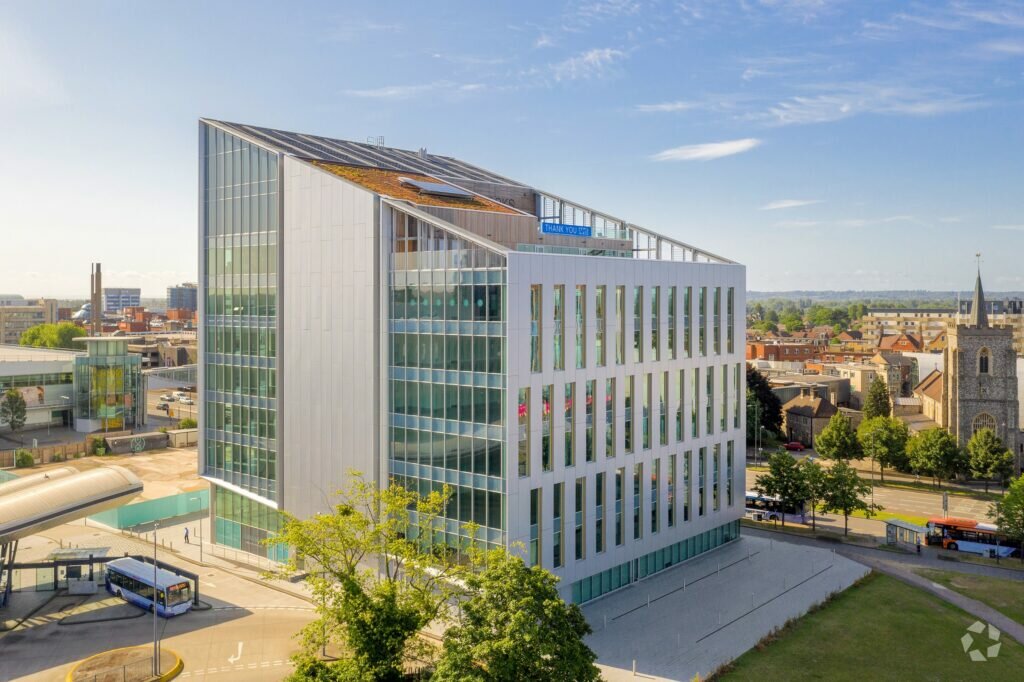Rather than pour money into expensive, sophisticated tech, The Future Works took an “organic approach” with strong design fundamentals to achieve superb air quality.
Tom Smithers, property director at AshbyCapital, says the building, just outside London in Slough, was not designed specifically to achieve a high AirRated score for indoor air quality. Instead, the idea was to create a space that simply met and exceeded the British Council for Offices’ best practice standards.
Confident in their design and curious about how well it performed in reality, the developers brought in the experts once it was complete. And it delivered, scoring the UK’s first Platinum AirScore. This is what real estate can learn from The Future Works.
The Future Works at a glance
Location: Slough, UK
Developer: AshbyCapital/U+I
Architect: Sheppard Robson
Use type: Office
Size: 100,000 sq ft (phase one of a 360,000 sq ft development)
1. Bells and whistles aren’t necessary…
“There are some buzzwords in the air quality industry, like HEPA filtration, ultraviolet filtration and things like bipolar ionisation, but we didn’t need any of those to achieve the Platinum AirScore.
”
Instead of installing a system that, for example, emits an electrical charge to break down volatile organic compounds (VOCs), the developers opted for “sensible things”, according to Smithers. Those include a ventilation system with well-proportioned ductwork, air curtains to stop contaminated air coming in and revolving doors – all fairly simple design choices.
Francesca Brady, CEO of AirRated, says that in cases like this, sophisticated air quality tech can be both unnecessary and inappropriate. If you don’t have much pollution to get rid of, using high grade filters is a waste of money.
She says: “We call it the organic approach, where filtration doesn’t change anything else apart from remove dust from the environment.”
2. … but integrating tech helps maintain standards
Where you do want tech is in maintaining and controlling air quality, which the building does through a digital twin from Smart Spaces.
By constantly monitoring air quality, tenants can respond to changes to conserve energy. Carbon dioxide levels will rise as occupancy rises. The amount of fresh air pumped through the building should, therefore, vary throughout the day.
“We give tenants, as part of their fit-out, the option to say, ‘What we want to do is start off with lower volumes of fresh air and as and when the CO2 ramps up… we can start to drive the systems harder to deliver more fresh air.
”
Tech can also help assure tenants that the spaces they are in are healthy and conducive for a productive day of work – especially now that growing numbers of people can and do choose to work remotely.
Screen provider 444 installed digital signs in The Future Works, which show real-time air quality, complete with explanations of what terms like VOCs and PM 2.5 mean.
How AirRated works
The AirRated certificate measures five parameters:
PM 2.5 – fine particulate matter or dust
Volatile organic compounds – gases emitted into the air (i.e. things you can smell, such as a new car or new materials in a building)
Carbon dioxide
Temperature
Humidity
Over a three-week period, AirRated measures these across several floors of a building to give a “representative view of the space”. It also measures outdoor pollution and undertakes a site survey to identify anything in the environment that mig ht affect the score, such as a nearby construction site or carpark.
These measurements, benchmarked against minimum requirements, generate a score out of 10 and determine the building’s rating: certified, silver, gold or platinum.
3. Certifying air quality takes a leap of faith
“It’s quite a scary thing to take it on,” Brady says of getting an AirScore rating. The design of a building might be good in theory, but how will it perform in reality? Until you – or AirRated – measure it, you won’t really know. You might find out that your building fails to qualify for a certification.
But there is pressure to do it. Anecdotally, Smithers says that air quality has become a top five concern for potential tenants.
That, Brady adds, highlights the incentive for taking a leap of faith and getting certified: “If it’s in the top five things that people are asking about, it’s almost got to the point where if you don’t do anything about it, it’s only going to negatively impact you.”
4. Treat your building like a vehicle
AirRated encourages clients to get their buildings checked about once every 13-14 months, staggered slightly to be just over a year between measurements. “We want to see it in summer, but we also want to see it in autumn and winter, because buildings can perform very differently in those two seasons,” says Brady.
Smithers says the process is “quicker than I expected and smoother than I expected”. There was a call to discuss initial measurements, a couple of out-of-range readings that had to be looked into and a small hiccup when someone had sprayed a sensor with a cleaning product, but otherwise it was “very, very straightforward” for the developer.
5. Air quality is where sustainability was five years ago
Over the last five years, sustainability has moved up the agenda partly because of regulatory pressure and individual net zero plans. While air quality does not yet have the same sorts of drivers, Brady argues that momentum is building.
In the UK, for example, ‘Part F’ building regulations around ventilation tightened earlier this year. Tenants have become more demanding, and, after more than two years of Covid heightening people’s consciousness of air quality – even as life feels more normal for many – there’s no going back, Brady says.
We have collectively learned too much about what we’re breathing to put up with poor indoor air quality. “We can’t unsee it now,” she says.
